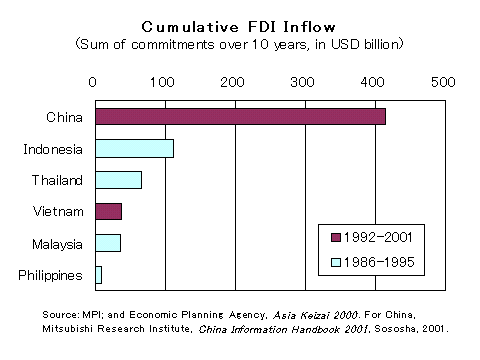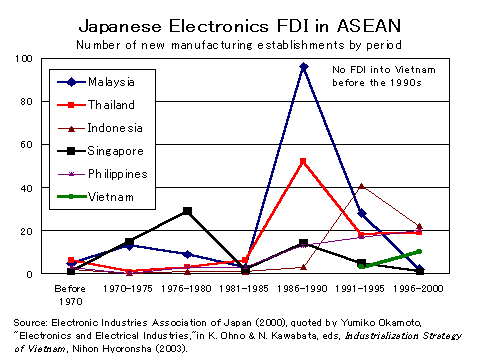Critical Mass of FDI
To create a new export base equipped with supporting industries, a developing country must attract a large number of FDI firms. But how many FDI firms must be attracted to ignite a virtuous circle between assemblers and parts producers? The experience of the East Asian countries shows that large and sustained inflows of FDI into a few selected countries can occur over several years. After such an inflow, industrialization of the host country is greatly accelerated. In the late 1980s when the yen appreciated sharply, Japanese manufacturers invested heavily in the ASEAN4 countries, transforming them into the exporters of electronic products. Since the early 1990s, China has absorbed huge amounts of FDI in all sectors, especially garments and electronics, to become the factory of the world.
If we compare the FDI receipts in East Asia during the critical ten years for each country (1992-2001 for China and Vietnam, 1986-95 for ASEAN4), Vietnam's performance is not outstanding but it does not look very bad either. China was the top host country by far, and Indonesia and Thailand also did fairly well. Vietnam's receipts were as large as Malaysia's and much larger than the Philippines'. However, total FDI, which includes mining, services and other activities, conceals the weakness of the Vietnam's manufacturing sector. We need to look at individual key industries separately.
According to the Electronic Industries Association of Japan, the ASEAN4 countries have cumulatively received far greater numbers of Japanese electronics FDI than Vietnam (see the graph in text). While Vietnam has received only 13, Malaysia and Thailand got 156 and 105, respectively. Their electronic industries suddenly popped up by the great wave of Japanese FDI in the late 1980s. It should also be noted that Singapore and ASEAN4 have much broader bases of parts and devices production than Vietnam. For each industry, the critical mass of FDI for becoming a player to be reckoned with in the global market would require 100 or more foreign investors coming to your country, not 10 or 20. Starting only from the mid 1990s, the agglomeration of FDI in Vietnam is still tiny. The country has a long way to go before it can boast a critical mass of FDI.


[Back to Main page (English)]
[Back to "Industrial Parks and FDI Attraction" (English)]
[Back to Main page (Japanese)]
[Back to "Industrial Parks and FDI Attraction (Japanese)]